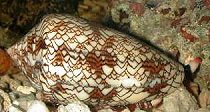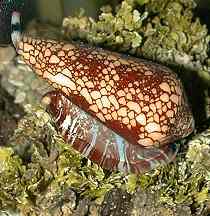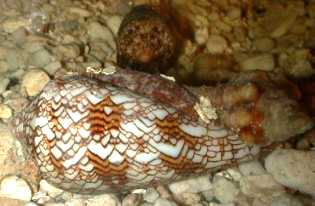| Cone Wars — Round 6 | ||
|
Within a few minutes of extinguishing the main aquarium lights, once again signs of life began to appear. Most of the cowries, including Helmut Lynx, were distributed around the water line at the top of the tank, and all the cones except Mark Episcopatus were buried. Mark was still moving his siphon, but had moved little since he was harpooned by Art, the Conus textile. Eduardo Magnificus was the first to move, bursting from the rubble at the bottom of the aquarium, and as might be expected, headed straight up the wall to the spot where Helmut was stationed. He climbed fairly quickly at first, but as he approached the cowry, he slowed until he was barely moving. I got my camera and waited to see what would happen.
When Eduardo got within a few millimeters of Helmut, he stopped. He extended his siphon to within about a millimeter of Helmut, and just sat there. And sat. Eduardo would move his siphon to either side, back and forth, but never made any attempt to harpoon the lynx cowry. For two hours I sat there, camera in hand, waiting for one of the snails to break the standoff. |
|
That afternoon, a good friend and outstanding photographer asked if he could borrow Tom and Eduardo for a little photo session in the ocean. I said sure, so he took the two cones on a field trip to Faga'alu, on the west side of Pago Pago Harbor.
|
 Conus episcopatus “Tom” |
|
He managed to get photos of both cones, as well as some other creatures that he had planned to photograph, but unfortunately lost track of Tom Episcopatus, and only came home with Eduardo. I was happy to have Eduardo back, but when I put him in the tank he immediately buried himself, and I didn't see him again for five days. Thus began a quiet period in the Cone Wars aquarium. For several days and nights there was little action, with all of the cones staying mostly buried, and the cowries touring the rocks and glass with no worries. I wondered if everyone had become accustomed to the aquarium, and had now entered a period of more typical activity since the novelty was gone. I decided to shake things up a bit, and after a few hours in the water, returned with three new residents for the tank. Meet Paul Textile, slightly smaller than Art, and the Omaria brothers, Andy and Gary. |
|
Each Conus omaria had a scar on his dorsum, but I decided it would be easy enough to tell them apart, as one had a straight scar (Andy) and one had a curved scar (Gary). I put all three in the tank at the same time, turned out the light, and waited for the fireworks. It took about five minutes for the three cones to bury themselves, and none of them resurfaced for the rest of the evening! I guess the new surroundings might not have been responsible for all the previous week's activity after all.
I thought it over carefully, and decided that all of the unsettled cowry activity might have been responsible for the cones' excitement, so I determined that I would collect a few more small cowries for the tank and see if anyone became more motivated. |
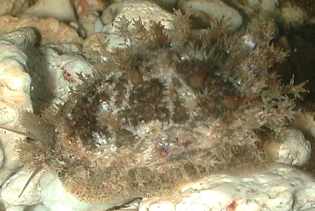 Cypraea erosa |
This time I went out and caught two Cypraea isabella and four C. erosa, and dropped them in the tank with the cones. I didn't notice much activity that evening, but in the morning there was one empty isabella shell and one empty erosa shell, so at least a couple of the cones had had dinner during the night. |
|
He climbed to the highest point on the coral branch, actually out onto the very tip of one of the branches, and stopped there. Eduardo continued on to the place where Helmut had been, and then actually stretched upward toward Helmut's new perch, with his siphon pointed directly at him. Eduardo knew the lynx cowry was up there, but he couldn't seem to figure out how to get to him. He pirouetted (slowly) several times; keeping his siphon aimed directly at Helmut, but never made any attempt to climb onto the coral. He eventually gave up and crawled away, and Helmut remained perched on the tip of the coral branch for the rest of the evening. It turned out that this was the last time Eduardo showed any particular interest in Helmut, as he seemed to have decided that Cypraea isabella and erosa were now more to his liking (or at least more suited to his hunting skills). |
| Cone Wars — Round 7 | |
|
About the time that Round 6 of the Cone Wars ended, it was my pleasure to welcome Betty Jean Piech and Homer and Ann Rhode to Samoa. We spent a lot of time in the water and riding around the island, so I didn't spend a tremendous amount of time watching the tank. Still, we did observe a few interesting things while they were here! I'll leave most of that story for others to tell. At least they got to meet Eduardo and Helmut. I arose at the crack of noon one morning and gathered up my snorkeling gear, and prepared to meet the other shellers at the Rainmaker Hotel. I decided to take a look in the aquarium before I left, just in case anything unusual was happening. It was. I had collected a pair of Bursa lamarckii the week before, and dropped them in the tank so that Betty Jean could look at them when she got here. As I watched, Art Textile's anterior tip came out of the gravel (he was almost exactly spire-down), and pushed the Bursa about half an inch off the bottom of the aquarium, harpooning him at the same time! I was stunned, as it appeared that Art had either trailed the Bursa from under the gravel, or had been lying in wait for some victim to happen into his snare. Anyway, the Bursa attempted to shut his trap door, but the damage was done. |
|
|
Art sat there working on extracting the Bursa until I left for the hotel. I wondered: are Cypraea really the prey of choice for the molluscivorous cones? I had seen a Conus omaria attack a Nassarius on dry land a few weeks before...
|
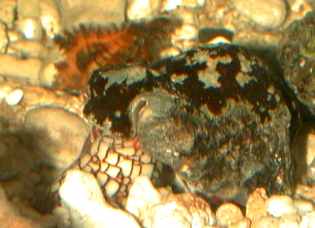 This is a picture of Art Textile ambushing the Bursa lamarckii from below. Notice that the C. textile is almost exactly inverted. |
|
Eduardo was right there with them, and Ross Canonicus even joined the hunt occasionally. Nobody seemed to have much luck while I was watching, but with the introduction of different cowry species into the tank, things began to change. Every morning when I'd check the aquarium before going to work or off to meet the others to go shelling, there would be one or two freshly-killed cowries in the tank. While my visitors were here, I removed 14 empty cowry shells from the aquarium! The preference was definitely for Cypraea isabella, with eight of them being eaten, along with five erosa and a single caurica. The population of cones in the tank at this time consisted of two C. textile, two C. omaria, one C. canonicus, and one C. magnificus. |
|
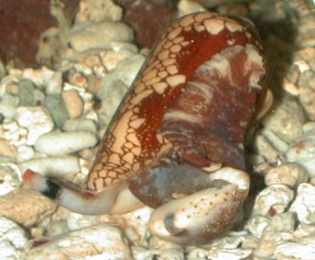 Conus Magnificus “Eduardo” extracting a Cypraea erosa |
|
|
By proximity, I could guess who had probably eaten several of the cowries. Although I couldn't blame Andy for any of the kills, Gary Omaria had taken up residence in one of the clumps of Halimeda, and I strongly suspect that he ate a Cypraea erosa and a C. isabella whose shells ended up in the same clump. It seems like his strategy of letting the prey come to him was more successful than brother Andy's head-on approach. Several empty cowry shells appeared in the middle of the open gravel over a short time period, and I am fairly certain that these were Art’s and Paul's ambush victims, assuming the attack on the Bursa lamarckii was typical Conus textile behavior. Eduardo had put on a couple of millimeters of new lip growth during this time, so he evidently had been catching his share of the cowries, even if the menu still didn't include Cypraea lynx. (Helmut had established a new residence in one of the corners near the top of the tank.) On the supposed last night of my visitors' Samoan holiday (had the flight not been cancelled), we finally had the chance to witness Eduardo in action. I turned the aquarium light off as soon as I found out that the Rhodes and Betty Jean were going to be with us another night, in hopes that they might get to witness some activity in the tank. Sure enough, Eduardo came out of hiding, and started slowly up one of the corners of the aquarium, directly below a Cypraea erosa. As Betty Jean said, "You can't really tell that he's moving, but the space between Eduardo and the cowry is shrinking." Eduardo continued the slow-motion stalking until he was within about an inch of the cowry, then extended his red proboscis as far as it would reach, and harpooned the hapless erosa. The erosa immediately fell to the bottom of the tank, but Eduardo didn't seem to know exactly what had happened to the cowry. He turned around and started moving sideways initially, then slowly turned toward the bottom of the tank. It appeared that he did indeed know where the cowry was after all, but then he did a course reversal and acted like he was going to resume his hunt at the top of the tank. By this time it was getting late, and the paralyzed erosa wasn't looking so healthy, so I pointed Eduardo in the right direction (I punched him off the wall of the aquarium). Once on the bottom, it only took Eduardo a couple of seconds to realize where the cowry was, and in a very short time he was working on extracting the cowry from its shell. I expected him to engulf the shell, but he didn't. He formed a semi-circular ring around the basal margin of the cowry shell with his foot, giving him something to push against. Within about 35 minutes, he had completely emptied the shell. I had assumed that he would immediately bury himself after eating, but not Eduardo. He resumed his hunting for the next hour, then finally decided to call it a night. He only took the next day off from his hunting, then was back to his normal rounds by the second day. It was beginning to appear that the cones in my aquarium had no interest in each other, each one having staked his territory and going about his business night after night. It continued this way until I got a call at work from my wife, who told me that Chuck Brugman had just caught a "big marmoreus" (it was a Conus bandanus) and had put it in my tank. |
|
| Cone Wars — Round 8 | |
|
After being informed by my wife of my new cone's arrival, I was anxious to get home and see the new guy in action. Bob Dayle had cautioned that Conus textile and Conus marmoreus were natural enemies, and I was curious to see if the reaction would be the same between the pair of C. textile, Art and Paul, and a deep-water first cousin of C. marmoreus, Conus bandanus.
When I arrived at home and checked on the aquarium, all was calm, with none of the molluscs in the tank active. I removed the Conus bandanus and measured him, a nice 83mm, and I dubbed the new resident Emilio. The lights had been on since Emilio had been introduced to his new home, so I extinguished them to see if the activity would pick up a little. In typical fashion, Eduardo Magnificus was the first to make a move. |
|
|
Eduardo came crawling out of the rubble, ignoring the new guy, and headed up the wall of the aquarium in search of an easy meal. He eased up to a Cypraea caurica positioned near the water line, sniffed at him, and turned around and headed back for the bottom of the tank. This time he went straight toward Emilio, evidently just recognizing him as an intruder. |
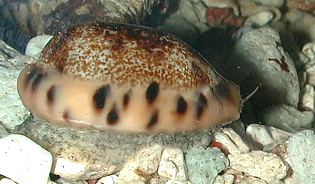 Cypraea caurica |
|
In faster-than-cowry-stalking speed, Eduardo marched up nose-to-nose with Emilio, extending his proboscis in a gesture that I was sure was not a "Welcome" in cone language. Emilio beat him to the punch, however, and snaked out his long white proboscis and harpooned my favorite Conus magnificus. Eduardo flinched, then turned to crawl away, but only moved an inch or so. The Conus bandanus withdrew back into his shell, and made no attempt at eating Eduardo.
I watched as the C. magnificus stretched out his foot and retracted it, and moved his siphon, but he seemed to be unable to coordinate his crawling muscles. His foot would move, but he couldn't crawl. This was the exact reaction that I had seen in Mark Episcopatus after Art Textile had stung him, and I knew that it didn't bode well. Eduardo remained in the same location for the next three days, except for the occasions when I removed him to verify that he was still alive, and like Mark, after three days he was dead. It was depressing, but life in the aquarium goes on. |
|
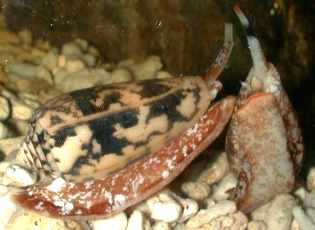 Conus striatus and Conus canonicus “Ross” discuss how poor the hunting has been recently |
Nothing much happened the rest of the evening, but when I arose the next morning practically every cone in the aquarium was out hunting, with the exception of Art and Paul. A few days before, with everything settled, I had introduced two new residents to the tank, a Conus tulipa and a Conus striatus.
|
|
Both of these new guys are piscivorous, but I thought I would just put them in the tank for a while to see how they interacted with the molluscivorous cones. The C. tulipa was the most active of all the cones I had had in my aquarium, and spent all the hours of darkness out hunting. He would "bulldoze" the cowries around the water line of the tank, and attempted to crawl down the water circulation pipe with the air bubbles in his face, but never made any attempt at eating anything in the aquarium, other than my little trigger fish. (He did finally catch the little guy.) This morning he was out crawling as usual, as were Andy and Gary Omaria and Ross Canonicus. Emilio had partially buried himself, with the tip of his siphon exposed just above the gravel. I sat watching all the action this morning, curious how Emilio would react to all the other cones moving about. Andy Omaria would be the morning's test case. Andy ambled toward Emilio, apparently lacking the sense of danger that Eduardo had displayed. As Andy came closer, Emilio extended his proboscis (which can be extended almost twice as far as his siphon, by the way). He "felt" for the Conus omaria's foot, found it, and zapped him. Andy was immediately unable to crawl, and Emilio didn't retract this time. He slowly, almost clumsily, repositioned himself above the aperture of the Conus omaria, and without extending his foot, proceeded to extract the victim from his shell. The process took almost an hour, but Andy's shell was completely empty when he was finished. Twelve hours in the tank, and Emilio had killed two of my molluscivorous cones. I was beginning to wonder why a "super-predator" like Conus bandanus didn't simply wipe out the cone population in an area, instead of being so uncommon like they are in American Samoa. After eating Andy, Emilio buried himself in the rubble, with his siphon against the front glass of the aquarium. He remained there for the next two days, and gave me the opportunity to watch his reaction as the other animals moved over him. Several times cowries crawled over the Conus bandanus' siphon, but he never showed the slightest interest. In fact, for the entire time he has been in the aquarium, Emilio has ignored the cowries, showing interest only in the other cones. After a couple of days in this position, the C. bandanus decided it was time to move, and so did Paul Textile. As Emilio dragged himself from the rubble, Paul emerged on the opposite side of the tank, obviously perturbed. He crawled directly up to Emilio, but not in a frontal attack like Eduardo had attempted. The Conus textile extended his pink proboscis when he was still six inches from the C. bandanus, and approached him from the side, about an inch behind his anterior tip. The Conus bandanus froze as the textile cone approached, and never moved to defend himself as he had done with Eduardo. Paul was strictly business, and never hesitated. He stopped his advance as soon as his proboscis would reach Emilio's foot, and stung the Conus bandanus the first place he touched. Emilio instantly withdrew, but Paul wasn't finished. He crawled a little closer, extended his proboscis under the lip of Emilio's shell, and appeared to harpoon him again. He repeated this five times, moving up the length of the shell toward the spire, and then turned around and marched off. Paul had obviously recognized the intruder as a dangerous enemy, and was intent on killing him, not on eating him. It wasn't quite a "David and Goliath" battle, but by volume, Emilio must be at least three times as large as the 63mm Conus textile. |
|
| Cone Wars — Round 9 |
|
After Paul Textile had made his calculated attack on Emilio Bandanus, he seemed satisfied, and headed toward the opposite side of the aquarium. I picked up my camera and was trying to get the thing to focus on Paul as he was exiting the scene when, through the viewfinder, I watched a different proboscis extend from the rubble and harpoon Paul in the side of the foot! Paul flinched, as all the cones have when they are stung, but continued on to the other side of the aquarium and stopped with his siphon against the glass. Art came crawling from the spot where he had ambushed Paul, and went over to investigate his victim. He didn't seemed particularly interested in Paul any longer, and after a ten minute stroll, buried himself in the rubble again, this time with the tip of his siphon exposed. Paul remained motionless against the aquarium glass for about an hour, and it was beginning to look like Conus textile venom is deadly to another Conus textile. Paul proved otherwise, though, and after a while he made another round of the aquarium. He ignored Emilio this time, then buried himself near the front glass. He also left the tip of his siphon exposed, and when one of the fish moved a rock or I tapped on the side of the tank, he would extend his proboscis and "feel" for any potential prey moving about! I was just about convinced that Emilio was on his way to bandanus heaven when he began to crawl forward, and then buried himself in the rubble. He continued forward until his siphon was also against the front glass of the aquarium, only a couple of inches from the spot where his nemesis, Paul, was buried. All was calm for some time after that, and as it appeared that things had settled down for the evening, I shut off the lights and went to bed. The next day things looked essentially as I had left them. There were no stray shells on the bottom of the aquarium, and I could clearly see Paul and Emilio against the glass. I could also see where Art was hiding, as his siphon or proboscis would occasionally protrude from the rubble. He had settled back into what must be his normal ambush position, barely under the surface of the aquarium floor. As I watched the two Conus textile extend their proboscides in response to any movement in the tank, I noticed that Art's was quite a bit darker than Paul's, which was only pale pink. Diet, or lack thereof, possibly? While I pondered the color difference, an oblivious Cypraea caurica stumbled around the corner, headed straight for Paul Textile's hiding place. As the C. caurica approached, Paul extended his proboscis to full length, whipping it around in an attempt to locate his potential breakfast. The cowry never seemed to detect the cone in front of him, even though Paul was certainly aware of the cowry's presence. The caurica continued forward until Paul's proboscis was raking across the front of his shell, and then he froze. Did you ever wonder whether a cowry can crawl backwards? This one did. And he didn't just rise up and turn, but his foot undulated in reverse motion, and he moved directly backward about an inch! Paul never seemed to figure out where the cowry went, and maintained his ambush position without giving chase. After the C. caurica had backed up, he turned and climbed up on the glass, making an arc above Paul's hiding spot, and then resumed his rounds on the gravel once he was clear of the danger zone. Paul went without breakfast. (See a photo series below of this attack and retreat) |
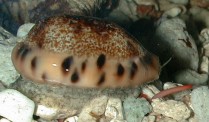 |
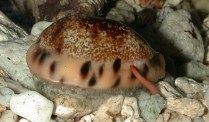 |
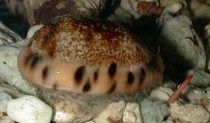 |
|
Here’s
the ambush sequence for the Cypraea caurica that crawled BACKWARD from
Paul Textile
|
||
|
Nothing else of note happened that morning, and all was calm when I darkened the living room that evening. It didn't take long for the Conus tulipa to sense that "nightfall" had come, and within a few minutes he had resumed his nightly hunting. He started out by climbing the glass, but in a short while had worked his way down to the bottom perimeter of the tank, obviously on course to crawl directly over Emilio Bandanus. I reached for my camera and waited. As the Conus tulipa continued toward Emilio, the bandanus cone sensed his approach, and began to extend his proboscis. The C. tulipa was crawling on the glass just above Emilio when he struck. A quick sting, and the Conus tulipa fell from the glass, toppling onto his back. He landed almost directly on Emilio's dorsum, and the Conus bandanus spent the next thirty minutes clumsily attempting to reposition himself to finish off the C. tulipa. During this time the Conus tulipa exhibited the same symptoms that the other cones had shown after being stung: he could move his siphon in and out, and could extend or retract his foot, but was unable to crawl or get any grip on the aquarium glass. Emilio did finally get himself and his victim oriented suitably, then harpooned the Conus tulipa a second time for good measure. The C. tulipa did not flinch this time. Emilio then wrapped his "mouth" around a section of the C. tulipa's foot, beginning near the posterior end, and then slowly stretched it down over the anterior part of the foot. As the tulip cone withdrew into its shell, Emilio went in with it. For two hours the Conus bandanus slowly extracted his victim, and you could even see the colors of the tissue being ingested through the semi-transparent tube that the C. bandanus used for feeding. For about an hour of that time, Emilio also had his siphon inserted into the tulipa shell. Could he tell by "smell" how the extraction was progressing? After Emilio had completely removed the Conus tulipa from its shell, he cast it aside and worked on getting himself and his new meal back into his shell. The C. tulipa wasn't terribly large, but the thin shell holds a lot of animal! I had guessed that the bandanus cone would settle down and hide for a day or so until he could completely retract into his shell, but Emilio didn't. It hadn't been too long since he had eaten Andy Omaria, so he wasn't empty and starving, but within about twenty minutes of finishing off the tulip cone he had managed to get his gut and foot both back into his shell. Emilio, now fat and happy, buried his nose in the gravel and all was quiet in the aquarium once again. The aquarium remained quiet for the next two days. I could still see a proboscis or siphon tip emerge from the gravel occasionally, so I knew where Art and Paul were hiding. If only Emilio had known. Emilio, now recovered from his feasting, decided to check out the territory on the other side of the aquarium. He pulled himself from the rubble, and slowly crawled toward the middle of the tank, directly into Art Textile's ambush. As he passed over Art, the results were predictable. Art reached up and harpooned Emilio, and since he was directly above the anterior tip of Art's shell, the trick he had used on Paul didn't work. I now believe that Paul must not have been successful in all his attempts at stinging the Conus bandanus, because the sting from Art stopped Emilio dead in his tracks. With Emilio withdrawn into his shell, it was hard to tell if Art stung him more than once, but I suspect that he did. In any case, Art made no attempt at eating the C. bandanus, but he did crawl from his hiding place and make a victory lap around the aquarium before burying himself once again. I watched Emilio carefully over the next two days, and it was a familiar pattern that I was observing. Like the others before him, and even his own victims, Emilio would retract his siphon, then extend it. At first he could extend his foot slightly, but after the first day he only seemed capable of moving his siphon. I checked on him a couple of times each day to see if he was still alive, but like all of the other "Cone Wars" victims, on the third day after being stung he was dead. And so ends this volume of the Cone Wars. Salute all the warriors, but hail Conus Textile, Champion of the Cone Wars. |
||
| EPILOGUE |
|
The Cone Wars "experiment" was hardly scientific, but it was educational for me, and I hope others enjoyed it, too. I learned several cone and cowry survival strategies, as well as getting a glimpse of the hunting methods that a few different species employ. The Conus textiles are certainly survivors, with a compulsion (and the equipment) to eliminate any potential competitors. The Conus canonicus survived mostly by staying out of the way of the bad guys, as did one of the Conus omarias. All but one of the original Cypraea caurica survived by using a variety of strategies, and then of course there is Helmut... Thanks for all your comments, and best to all you Conch-L'ers! Cheers, Don |
|
All
photos on the Conewars article are by Don Barclay.
|
